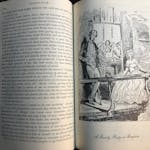Over the past few years, Ruth Bader Ginsburg's eloquent, impassioned and liberal opinions, rendered in feisty dissents from the bench of the U.S. Supreme Court, have made her a hero to millions. The fact that Ginsburg is an octogenarian, barely 5 feet tall, and 100 pounds in soaking wet robes, adds to her style and charm. Her pluck, brilliance, winning smile and a lifetime spent battling in courtrooms over the rights of women to get a fair shake in the eyes of the law have made Ginsburg an iconic figure to liberals in an age where the highest court in the land has continually shifted to the right.
A clever nickname that ties her improbably to a rap music legend, a ubiquitous T-shirt that highlights that connection and a popular documentary out this year that tells her life story with verve and style have thrust RBG — or the Notorious RBG, as the T-shirt would have it — into pop stardom. A Hollywood feature film that highlights one of her cases as head of the American Civil Liberties Union's women's rights project in the 1970s is due out this year, adding to the flood of Ginsburg-inalia.
Now comes a thick biography of the justice, which takes a deeper look at her life and legal career. "Ruth Bader Ginsburg: A Life" by Jane Sherron De Hart, former director of women's studies at the University of North Carolina in Chapel Hill and a now history professor at the University of California-Santa Barbara, offers a detailed account of Ginsburg's childhood in Brooklyn, her close relationship with her mother, who died of cancer when Ruth was just beginning college at Cornell University, and the difficulties faced by a brilliant young woman in the halls of academe in the 1950s.
There were only nine women in her Harvard Law School class, and no female professors. The dean was notorious for directly demanding of the young women accepted at the school: "Why are you at Harvard Law School taking a place that could have gone to a man?" He thought of it as a joke.
Despite the difficulties placed before her, Ginsburg succeeded at all levels of the law, landing an academic job at Rutgers University in the 1960s, and then a job as chief counsel for the aforementioned women's rights project at the ACLU during the 1970s. It was in this position that Ginsburg was thrust into the spotlight of the feminist fight for equal rights. She appeared multiple times before the Supreme Court, inching the cause of equal rights forward in landmark cases.
Ginsburg was placed on the bench of the U.S. Court of Appeals for the District of Columbia by Jimmy Carter in 1980 and was nominated for the Supreme Court by Bill Clinton in 1993. All the while, she was supported by her husband, Cornell and Harvard Law School classmate Marty Ginsburg. Combined with Ruth, the two made one of the more exemplary couples in U.S. political history.
De Hart's thorough biography relates this life story with a nice sense of the sweep of feminist and legal history that is contained within it. De Hart offers compelling background narratives for many important decisions, cases, dissents and briefs that have crossed over or stemmed from Ginsburg's desk in her 50-plus years as a lawyer and judge. For all this, there is less of a sense of her own thoughts and feelings than one could hope for. Personal expressions of the deep and animating factors that have guided her life are missing. Beyond her legal writings and opinions, the inner Ruth remains elusive.
Tim Brady is a writer and biographer in St. Paul. His latest book is "His Father's Son: The Life of General Ted Roosevelt Jr."
Ruth Bader Ginsburg: A Life
By: Jane Sherron De Hart.
Publisher: Alfred A. Knopf, 723 pages, $35.






